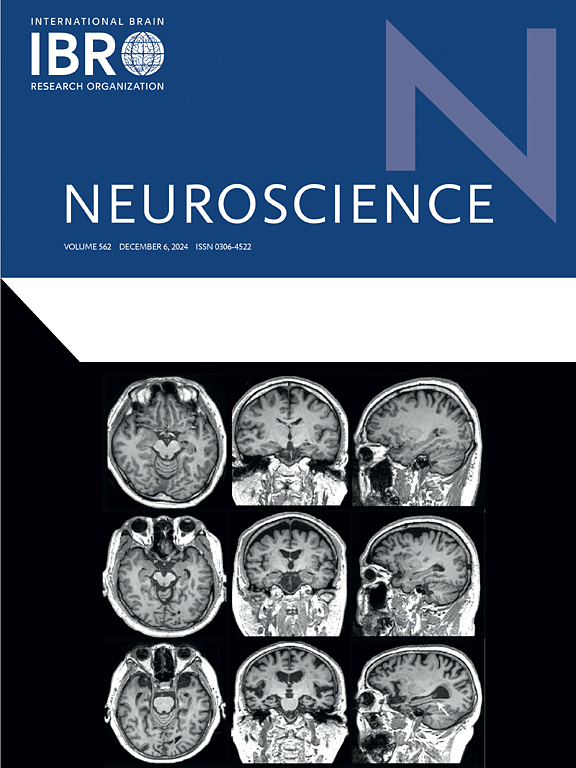内隐运动序列学习中对SMA和M1刺激的年龄特异性神经反应:来自并发tDCS-fNIRS方法的见解。
IF 2.8
3区 医学
Q2 NEUROSCIENCES
引用次数: 0
摘要
内隐运动序列学习(IMSL)对于自动化运动技能至关重要,但它随着年龄的增长而下降,影响独立性和生活质量。本研究采用一种新的并发经颅直流电刺激(tDCS)和功能近红外光谱(fNIRS)方法研究初级运动皮层(M1)和辅助运动区(SMA)在IMSL中的年龄特异性作用。20个年轻人(21-32 岁[M = 24.3 ± 3.26])和二十老年人(60 - 76 岁[M = 67.5 ± 4.88])连环反应时间执行任务(SRTT)三个交叉,平衡与阳极的tDCS SMALeft瞄准我),2)M1Left或iii)虚假的刺激在任务。使用20通道fNIRS测量刺激前、刺激中和刺激后的神经活动和连通性,覆盖前额叶、运动前和运动区域。结果显示SRTT表现存在显著的年龄相关差异,尽管两组都有练习驱动的改善,但老年人的表现始终较差。虽然tDCS在行为上没有增强运动学习,但明显的神经效应出现了,表明了年龄特异性调节。在老年人中,M1刺激在运动前区(PMA)引发了任务依赖的、不对称的O2Hb变化:在序列阻滞期间,PMARight活动减少,在随机阻滞期间,pmalleft活动增加,与之相反。SMA刺激使老年人PMARight- PFCRight和PFCLeft-PFCRight之间的连通性增强,反映了其在空间整合和运动规划中的作用。这些发现促进了对imsl相关神经可塑性的理解,强调了优化tDCS方案以支持老年人运动学习的重要性。本文章由计算机程序翻译,如有差异,请以英文原文为准。
Age-specific neural responses to SMA and M1 stimulation during implicit motor sequence learning: Insights from a concurrent tDCS-fNIRS approach
Implicit Motor Sequence Learning (IMSL) is critical for automating motor skills, yet it declines with age, impacting independence and quality of life. This study investigated the age-specific roles of the primary motor cortex (M1) and supplementary motor area (SMA) in IMSL using a novel concurrent transcranial direct current stimulation (tDCS) and functional near-infrared spectroscopy (fNIRS) approach. Twenty younger adults (21–32 years old [M = 24.3 ± 3.26]) and twenty older adults (60–76 years old [M = 67.5 ± 4.88]) performed a Serial Reaction Time Task (SRTT) in three cross-over, counterbalanced sessions with anodal tDCS targeting: i) SMALeft, ii) M1Left, or iii) sham stimulation during task. Neural activity and connectivity were measured pre-, during-, and post-stimulation using a 20-channel fNIRS, covering prefrontal, premotor, and motor regions. Results revealed significant age-related differences in SRTT performance, with older adults consistently performing poorer despite practice-driven improvements in both groups. While tDCS did not enhance motor learning behaviourally, distinct neural effects emerged, demonstrating age-specific modulation. In older adults, M1 stimulation elicited task- dependent, asymmetric O2Hb changes in the premotor area (PMA): decreased PMARight activity during sequence blocks and increased activity during random blocks, with opposite patterns in PMALeft. SMA stimulation normalised weak PMALeft-prefrontal connectivity in older adults, whereas younger adults showed strengthened connectivity between PMARight- PFCRight and PFCLeft-PFCRight, reflecting its role in spatial integration and motor planning. These findings advance the understanding of IMSL-related neuroplasticity, highlighting the importance of optimising tDCS protocols to support motor learning in ageing population.
求助全文
通过发布文献求助,成功后即可免费获取论文全文。
去求助
来源期刊

Neuroscience
医学-神经科学
CiteScore
6.20
自引率
0.00%
发文量
394
审稿时长
52 days
期刊介绍:
Neuroscience publishes papers describing the results of original research on any aspect of the scientific study of the nervous system. Any paper, however short, will be considered for publication provided that it reports significant, new and carefully confirmed findings with full experimental details.
 求助内容:
求助内容: 应助结果提醒方式:
应助结果提醒方式:


